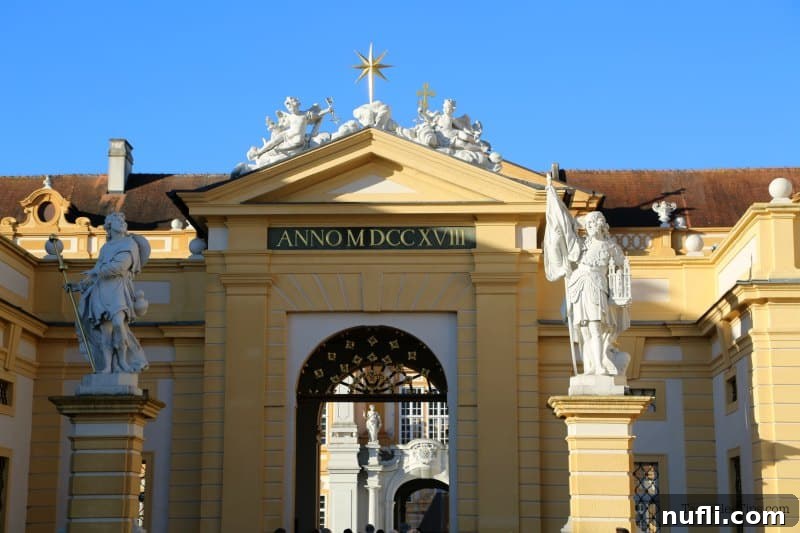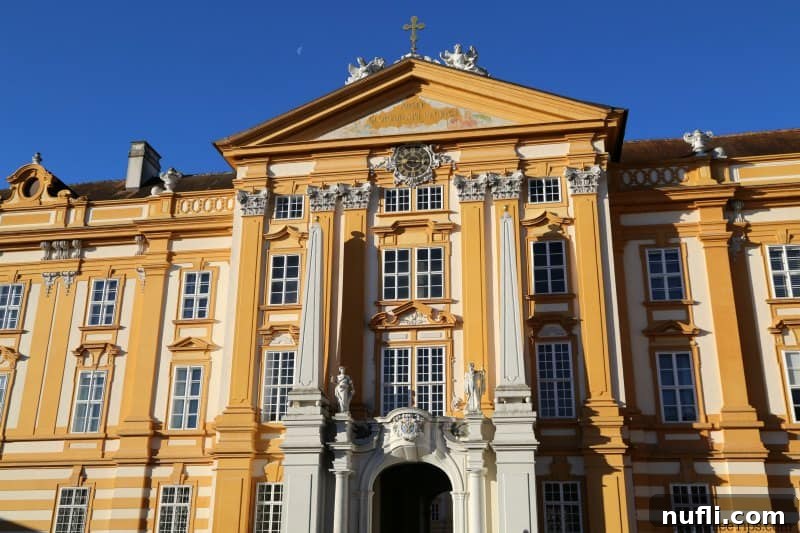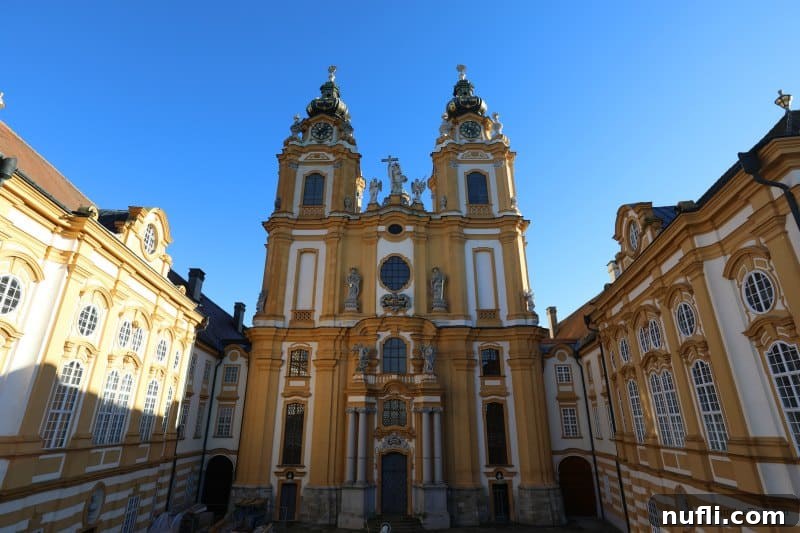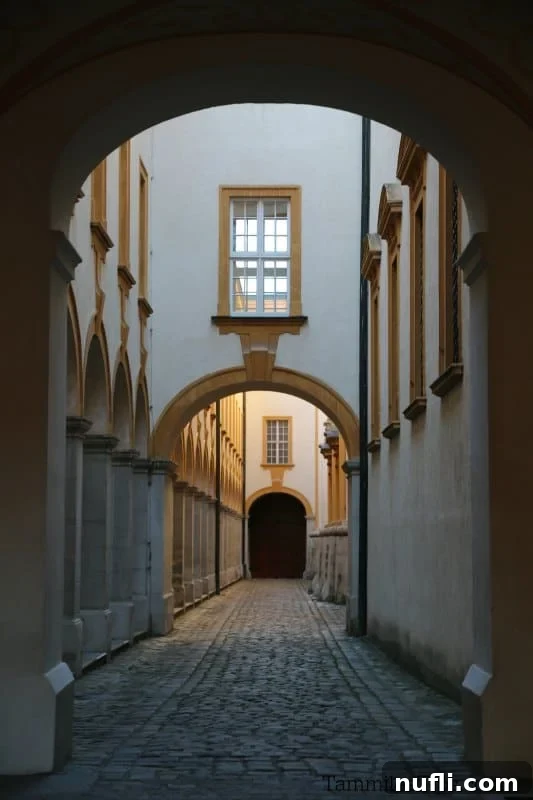Embarking on a journey along the majestic Danube River aboard a Viking cruise is an experience rich with history, culture, and breathtaking landscapes. Our “Vikings Castles & Legends” itinerary delivered exactly that, offering a curated selection of shore excursions that brought ancient tales and architectural marvels to life. Among the many highlights, the Melk Abbey Visit tour stood out as an unforgettable immersion into Austria’s Baroque splendor and profound monastic heritage. Leaving directly from the comfort of the Viking Vili, this guided walking tour provided an intimate glimpse into one of Europe’s most magnificent Benedictine monasteries.

For those eager to plan their own Danube adventure or explore the wonders of Austria, here are some quick links to help you get started:
- 🏨 Find the perfect hotels and vacation rentals for your stay.
- 📍 Discover and book unforgettable tours and activities in the region.
Discovering Melk Abbey: A Jewel on the Danube in Melk, Austria
Perched majestically on a rocky outcrop overlooking the confluence of the Danube and Melk rivers, Melk Abbey is not merely a monastery; it is a sprawling masterpiece of Baroque architecture and a beacon of spiritual and intellectual life. Recognized as a UNESCO World Cultural Heritage Site, its sheer scale, intricate detailing, and profound history make it an absolute must-visit for anyone traveling through Austria’s Wachau Valley.
The history of Melk Abbey stretches back over a millennium. Since 1089, Benedictine monks have continuously inhabited and enriched this sacred ground, dedicating themselves to prayer, work, and scholarship. What began as a castle belonging to Leopold II, Margrave of Austria, was eventually transformed into a monastery, forever changing its destiny. The Abbey you witness today, with its iconic yellow façade and towering domes, is the result of an ambitious Baroque reconstruction project undertaken between 1702 and 1736. Orchestrated by the brilliant Austrian master-builder Jakob Prandtauer, with significant contributions from other renowned artists like Josef Munggenast and Paul Troger, this architectural marvel was designed to embody the glory of God and the Habsburg monarchy.


Stepping Back in Time: The Imperial Rooms and Abbey Museum
Our guided tour commenced with a journey through the former Imperial Rooms, now home to the Melk Abbey Museum. This exceptional exhibition, aptly titled “The Path from Yesterday to Today,” offers a fascinating exploration of the Abbey’s illustrious 900-year history. What makes this museum truly captivating is its innovative blend of past and present. Ancient artifacts and priceless antiques are thoughtfully displayed within modern lighting and contemporary settings, creating a dialogue between centuries. Imagine illuminated manuscripts nestled beside interactive touchscreens, or centuries-old vestments presented with dynamic visual projections.
The installations within the museum are masterfully crafted to tell the Abbey’s story in an engaging and immersive way. From subtle changes in lighting that shift the ambiance to alterations in floor textures that guide your perception, every element contributes to a compelling narrative. Visitors are invited to trace the evolution of monastic life, the Abbey’s role in European history, and its enduring cultural significance. Each room reveals another layer of this incredible institution, preparing you for the grandeur that lies ahead.
Regrettably, I am unable to share photographs of the Abbey’s magnificent interiors. A policy has been put in place, at the Abbot’s discretion, prohibiting photography within the Abbey’s sacred spaces. This decision, prompted by the past disrespectful behavior of some tourists, aims to preserve the sanctity of the church and ensure a reverent experience for all visitors. While disappointing for photographers, it encourages a deeper, more mindful appreciation of the art and atmosphere, forcing one to truly live in the moment and absorb the splendor without the distraction of a lens.
The Heart of the Abbey: Marble Hall, Library, and Collegiate Church
Our knowledgeable guide expertly led us from the engaging Abbey Museum into the very heart of the complex, unveiling a series of breathtaking spaces. The tour took us through the opulent Marble Hall and, to my particular excitement, the world-renowned Abbey Library. Along the way, we delved into the Abbey’s rich history, understanding the meticulous craftsmanship that brought it to life, and learning about its multifaceted functions in the present day.
The Marble Hall (Marmorsaal)
The Marble Hall is an absolute feast for the eyes, a quintessential example of Baroque grandeur. This magnificent hall, once a dining room and reception area for imperial guests, is adorned with sumptuous marble, gilded stucco, and awe-inspiring frescoes by Paul Troger. The ceiling painting, depicting Hercules making a choice between virtue and vice, is particularly striking, creating an illusion of boundless space and divine intervention. The sheer opulence and artistry of this room are designed to impress, reflecting the power and prestige of both the Abbey and the Habsburg Empire.
The Abbey Library (Stiftsbibliothek)
Adjacent to the Marble Hall lies the legendary Abbey Library, a treasure trove of knowledge and a monument to intellectual pursuit. While photos are not permitted, the memory of its grandeur remains vivid. This stunning library houses an immense collection of medieval manuscripts, incunabula, and rare books, many of which date back centuries. The Baroque design of the library hall itself is breathtaking, with intricate frescoes, grand bookshelves, and a serene, scholarly atmosphere. It serves not only as a repository of knowledge but also as a testament to the Benedictine order’s long-standing commitment to education and scholarship. It’s truly a place where time seems to stand still, allowing visitors to ponder the vastness of human thought contained within its walls.
The Collegiate Church (Stiftskirche)
Though not explicitly detailed in the original content, no visit to Melk Abbey is complete without experiencing its monumental Collegiate Church. This is the spiritual and artistic climax of the complex, a Baroque masterpiece of unparalleled splendor. Dedicated to Saints Peter and Paul, the church’s interior overwhelms with its vibrant frescoes by Johann Michael Rottmayr, intricate altars, and a dazzling golden pulpit. The immense dome and the interplay of light and shadow create an ethereal atmosphere, inviting contemplation and awe. Every surface is adorned with exquisite detail, from the statues of saints to the elaborate stucco work, making it one of the most significant Baroque churches in Austria.
Beyond its historical and artistic significance, Melk Abbey remains a vibrant, active community. The site houses a prestigious Benedictine grammar school, providing education to generations of students, upholding a tradition of learning that dates back centuries. Furthermore, the Abbey Library continues to be a center for theological and historical research, leveraging its invaluable archival collections to contribute to contemporary scholarship. This living legacy ensures that the Abbey is far more than a museum; it is a dynamic institution dedicated to faith, education, and culture.

Unforgettable Details and Practical Tips for Your Visit
The Iconic Spiral Staircase
One particular architectural marvel I was keenly eager to see within Melk Abbey was its renowned spiral staircase. Tucked away discreetly, this staircase is a stunning example of Baroque design, with its elegant curves and, most notably, the gorgeous paintings that adorn its underside. As our tour concluded, and finding myself in an area where no prohibitive signs were visible, I admit I couldn’t resist capturing a quick photograph of this magnificent detail. It’s a truly captivating feature, and I highly recommend that you make sure to look up as you descend or ascend, lest you miss this hidden artistic gem.

Treasures from the Gift Shop
At the culmination of the Abbey tour, visitors are afforded the opportunity to browse the well-stocked gift shop. This isn’t just any souvenir shop; it offers a unique selection of products, many of which are lovingly produced by the resident Benedictine monks themselves. Keep a keen eye out for their exquisite wines and liqueurs, which are crafted using traditional methods, along with delicious apricot juice and jams, honey, and gourmet chocolates. Purchasing these items not only provides you with a tangible memory of your visit but also directly supports the ongoing work and preservation of the Abbey.
Exploring the Abbey Park and Baroque Garden Pavilion
For those visiting Melk Abbey between May and October, a truly delightful experience awaits in the Abbey Park and the enchanting Baroque Garden Pavilion. Unfortunately, our visit in November meant these areas were closed for the winter season. However, during the warmer months, visitors can freely explore these beautifully landscaped grounds, which offer serene walkways, vibrant floral displays, and breathtaking views of the surrounding Wachau Valley and the Danube. The Baroque Garden Pavilion itself is a charming architectural feature, often hosting temporary exhibitions and providing a tranquil retreat from the grandeur of the main Abbey building. Planning your visit during these months is highly recommended to fully appreciate the outdoor splendor of Melk.

Your Melk Abbey Experience: A Journey Through Time
A visit to Melk Abbey is far more than just a tour of an old building; it’s a profound journey through a thousand years of history, spirituality, and artistic achievement. From its strategic position overlooking the Danube to its awe-inspiring Baroque interiors and its living monastic community, the Abbey leaves an indelible impression. It perfectly encapsulates the “Castles & Legends” theme of our Viking River Cruise, offering a rich tapestry of stories, architectural brilliance, and cultural heritage. Whether you are a history enthusiast, an architecture admirer, or simply seeking a moment of reflective beauty, Melk Abbey promises an experience that will enrich your understanding of Austria and the enduring legacy of the Benedictine order.
For those planning a similar adventure or simply yearning for more tales from the waterways, delve into our other Viking River Cruise articles:
- The Enchanting Sound of Music Tour in Salzburg
- Sailing Through the Scenic Wachau Valley with Viking River Cruises
- Exploring the Magical Salzburg Christmas Market
- Excited to Board the Viking Vili: Our Castles & Legends Cruise
- A Comprehensive Munich City Tour with Viking River Cruises
Be sure to check out all of our Viking River Cruise Travel Guides for more inspiration and planning tips!
Please note: This unforgettable trip was a hosted experience with Viking River Cruises. All opinions and insights expressed in this article are entirely our own.
